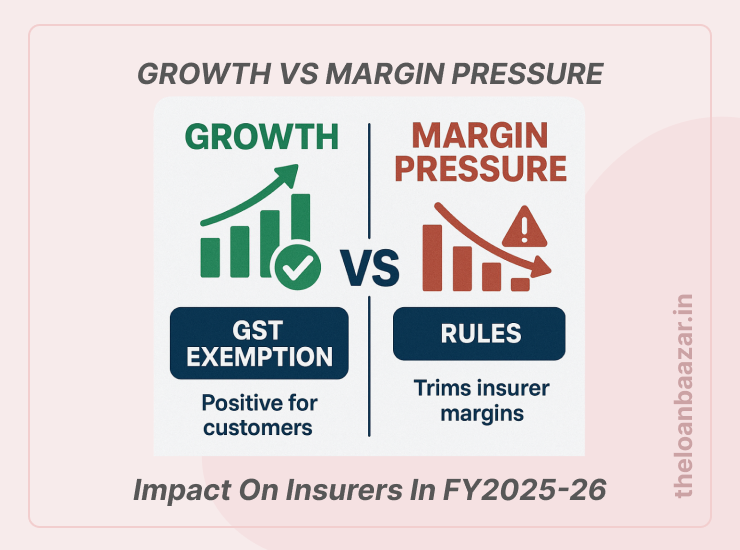The Indian insurance sector is facing a dynamic shift in FY2025-26, with regulators introducing reforms aimed at improving customer accessibility while also tightening compliance for insurers. While the recent GST exemption on insurance premiums is a welcome move for policyholders, insurers are now dealing with new margin pressures arising from the loss of input tax credit (ITC) and revised surrender value rules.
This blog explores the growth vs margin pressure paradox—where higher customer uptake could coexist with shrinking profitability for insurers.
GST Exemption – A Growth Catalyst for Insurance
The Government of India announced a GST exemption on insurance premiums, aimed at making life and health policies more affordable. This move is expected to:
- Lower premium costs for policyholders
- Encourage first-time buyers to invest in protection and savings plans
- Support penetration of life and health insurance in underserved markets
According to early estimates, the GST waiver could increase insurance uptake by 5-8% in FY2025-26, particularly in the middle-income segment.
The Hidden Cost: Loss of Input Tax Credit (ITC)
While customers benefit from lower premiums, insurers are on the losing side of ITC. Insurance companies traditionally availed input tax credit on services such as:
- Agent commissions
- Marketing expenses
- IT infrastructure and technology services
- Office rentals and operational costs
With GST exemption in place, these input credits can no longer be claimed, directly hitting insurer profitability. Analysts expect this shift could shave off 20–100 basis points (bps) from profit margins in FY2025-26, depending on the insurer’s expense structure.
Surrender Value Rules – Trimming Margins Further
Adding to the challenge, the Insurance Regulatory and Development Authority of India (IRDAI) introduced new surrender value rules that ensure policyholders receive better payouts when discontinuing policies.
While this enhances consumer trust and policyholder benefits, insurers now face:
- Lower persistency margins – since more customers may surrender policies without heavy penalties
- Increased liabilities – higher surrender values mean higher payouts
- Reduced cross-subsidization – insurers relied on lapsed or surrendered policies to balance books
This rule, while customer-friendly, further compresses margins for insurers already battling ITC losses.
Balancing Growth and Profitability
The dual impact of GST exemption and regulatory reforms creates a growth vs margin trade-off:
-
Positive Growth Drivers
-
Lower premiums improve affordability
-
Wider insurance penetration in Tier-II & Tier-III cities
-
Improved customer sentiment and trust due to fairer rules
-
-
Margin Pressures
-
Loss of ITC increases operational costs
-
Surrender value payouts increase financial liabilities
-
Competitive pricing limits insurers’ ability to pass costs to customers
-
This means insurers must innovate their operating models to balance growth and profitability.
Strategic Responses by Insurers
To navigate the pressure, insurers are expected to adopt multiple strategies:
- Digital Transformation – Reducing distribution and service costs via AI-driven claims, chatbots, and self-service portals.
- Product Redesign – Creating leaner, transparent products with lower costs but sustainable profitability.
- Cost Rationalization – Streamlining agent commissions and marketing spends.
- Cross-Selling Opportunities – Leveraging bancassurance and fintech partnerships for bundled offerings.
- Focus on Persistency – Encouraging long-term policy continuation through loyalty rewards and digital engagement.
Industry Outlook for FY2025-26
- Topline Growth: Expected to rise due to premium affordability and increased awareness.
- Margin Compression: Profitability will shrink by 20–100 bps due to ITC loss and surrender value reforms.
- Customer-Centric Industry: Regulatory changes are making the insurance sector more transparent and policyholder-friendly.
- Investor Watchpoint: Valuations of listed insurers may face volatility due to near-term profitability risks.
In short, FY2025-26 will test insurers’ ability to adapt—those who can digitize, cut costs, and scale customer acquisition may thrive, while laggards could see prolonged margin pressures.
Q1: How does GST exemption impact customers?
The GST exemption reduces the effective premium cost, making life and health insurance more affordable for customers.
Q2: Why are insurers losing margins despite higher customer uptake?
Insurers lose input tax credit (ITC) benefits, which increases operational costs, and new surrender value rules reduce their profitability further.
Q3: How much margin pressure are insurers expected to face?
Analysts estimate a 20–100 basis points (bps) impact on insurer margins in FY2025-26.
Q4: What are the new surrender value rules?
IRDAI has revised rules to ensure customers get better payouts when surrendering policies, which increases insurer liabilities.
Q5: What strategies can insurers adopt to manage margin pressure?
Insurers can focus on digitalization, product innovation, cost control, and improving persistency ratios.
Conclusion:
The GST exemption is a growth booster for customers and policy penetration, but insurers must prepare for tighter margins. In FY2025-26, the real winners will be insurers who balance affordability, customer-centricity, and operational efficiency.













